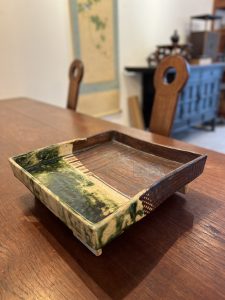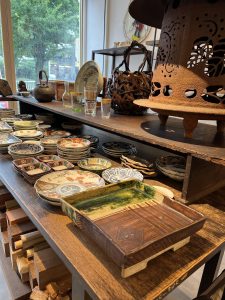織部焼もいろいろあります。(愛知県名古屋市千種区姫池通 骨董買取 古美術風光舎)
2024.08.31
みなさまこんにちは、スタッフYでございます。
台風10号がおもいのほか迷走した進路を辿っておりますね。巷では九州をはじめ有名温泉地を巡っている足取りのようだと揶揄したりしておりますが、とにもかくにも災害への備えと被害がおこらないようにと祈るばかりであります。
また、いろいろなスケジュールの変更があったりと近々の予定はあきらめる方も多かったのでは。自分も秋に向けてどこか出かるプランを練る方向へ切り替えてることにしましたが、少し先の予定なのですが、とある焼物の窯元を巡る計画をしております。
というのも、このところ焼物が少々気になっておりまして。先日も織部焼において種類がいくつかあり様々な呼称を耳にするのですが、よくわからずスルーしていましたので、本日は自分の脳内のおさらいをしていきたいと思います。少々お付き合いくださいませ。
まずは織部の簡単なおさらいをしますと、
織部は、今から四百年程前の桃山時代に、茶の湯と共に花開いた美濃の窯(岐阜県東濃地方)で焼かれた陶器のうちのひとつでして、一般的には銅緑釉(銅により緑色に発色する釉薬)を施した陶器をさすことが多いようですが、黒釉を掛けた織部黒や銅緑釉を掛けていない絵織部などもあります。型にはまらず斬新で大胆にデフォルメされた造形は、その時その時代においての一般概念を打ち破る革新的なところが特徴でしょうか。
織部と言う名称は武将で利休の高弟子であり茶人であった古田織部によるものですが、一説には古田織部が今で言うプロデューサー兼デザイナーであり、織部好みの陶器を焼かせていたとも言われておりますが、真相はわからないようであります。
ただ、当時茶の湯のリーダー的存在であった古田織部ですから何らかのかかわりはあったのでしょうね。総合プロデューサー織部によって桃山時代の茶の湯が発展し、デザイナー織部の元、陶工たちの創造力が掻き立てられ育てられた陶器なのかな。などと、個人的には勝手に想像しております。

こちらは店舗にあります鳴海織部

織部焼、種類をいくつかあげていきますと、
1.黒織部
鉄釉を掛け分けて、掛け残した余白の部分に鉄絵を施し、その上に長石釉を掛けたもの。瀬戸黒と同じ焼成方法で、焼成中の窯から引き出すことで急冷させて黒色に発色させ、黒織部と織部黒といえば沓茶碗というほど沓形の茶碗が多く見られる。文様も織部の特徴ともいえる幾何学文様が自由奔放に描かれた秀作が多く、陶工にとっても腕の見せ所だったのか、面白みのある茶碗が多い。ほとんどが茶碗だが、茶入れ、香合などにも良いものが見られる。
2. 織部黒
器全体に鉄釉が掛けてあり、黒織部と同じく窯から引き出して黒色に発色したもの。織部黒もほとんどが沓茶碗で、口縁部分に鉄釉と長石釉を二重掛けして釉の変化をねらったものが多く見られ、その他に瀬戸黒に似た半筒形の茶碗もあるが、器面をヘラなどで削り手で形を整えるなど意匠の強いものとなっており、瀬戸黒とは違ったものといえる。
3.青織部
部分的に銅緑釉を掛け分けて余白の所に鬼板(褐鉄鉱)などで文様を描いてあるもの。銅緑釉の緑色は、長石と土灰などの釉に銅を入れて酸化焼成することで得られる色であり、この釉は還元焼成すると赤色に発色する。
織部のなかには緑色が部分的に赤く発色したものも見うけられるが、鉄絵の上には長石釉が掛けられている。織部といえばこの手のものを指すぐらい、種類も多く大量に作られている代表的な陶器。但し、茶碗として作られたものはほとんどなく、特に食器類が多く、鉢、向付などには三日月・舟形・扇の形など色々な形のものが見られる。
4.志野織部
織部として焼かれたものではなく、志野を作ろうとして窯の様式の変更により次第に織部風になっていったものを志野織部という。志野は穴窯で焼かれていたが、次第に熱効率の良い登り窯へと変わったことから温かみのあるふんわりとした志野独特の釉調が薄れ、下絵もはっきりと見えるようになり、光沢の強いものへと変化。現在でも穴窯で志野を焼かれている方がいるように、窯の温度が上がりにくく冷めにくい窯で時間を掛けてじっくりと焼かなければ、志野独特の釉調は得られない。
5.絵織部
白土に鉄絵を施して長石釉だけ掛けられたもの。上記に書いた志野織部とは違い、明らかに織部としての意匠をもって作られたもので、銅緑釉が掛けられていないので、鉄絵の文様が強調されたものになっている。
6.総織部
銅緑釉だけが器全体に掛けられたもの。皿などには、銅緑釉の下に文様を線彫りした物などが多く見られる。総織部の茶碗はほとんど見あたらず、皿、鉢、香合などが主で、変わったところでは香炉、硯、煙管などの細工物がある。
7.鳴海織部
赤土と白土を継ぎ合わせて白土のところへ銅緑釉を掛け、赤土には白泥と鉄絵で文様を描き長石釉を掛けてあるもの。青織部よりもカラフルで複雑な文様になっており、赤土の素地に白と黒を使い文様を強調することで立体感が生まれ、軽やかな動きのある文様といえる。継ぎ合わせて作るので型物の手鉢や向付が多いが、ろくろ作りの沓茶碗にも良いものが見られる。鳴海織部の名称は名古屋の鳴海地方で作られたと思われていたため、この名称が付いたという説もあるが、詳細はわからない。
8.赤織部
赤土だけで作られており、素材の赤土に鉄絵で文様を描いたり、白泥と鉄絵で描き長石釉を掛けてあるもの。素材の白土と銅緑釉のない鳴海織部ともいえる。香合や向付などに見られる。
9.伊賀織部
美濃伊賀とも呼ばれ、三重県の伊賀焼の花生や水指などに倣って織部の窯で作られたもの。伊賀焼は窯の燃料でもある木の灰が器面に付いて青緑色のビードロといわれる自然の釉だれが景色となっているが、それを織部では白泥を部分的に掛け、全体に薄く土灰釉を掛けてからビードロの代わりに飴色の鉄釉を流し掛けにしている。
10.唐津織部
美濃唐津とも呼ばれ、絵唐津に倣って織部の窯で作られたもの。唐津でも織部に倣って作られた沓茶碗などがあり、美濃と唐津の交流がうかがえる。
主だったものをあげてみましたが多種多様でありました。美濃で焼かれ、一般的には銅緑釉を使用していたということで、自由で斬新な焼物と進化していったのでしょうか。
それにしても現代でも使用され、本人の名と共に400年も生き残っているわけですから、古田織部のプロデューサー兼デザイナーとしてのその手腕にも恐れ入りました。と、私の感想はその作品の重みや歴史とは反対に申し訳ないぐらい、いたって浅いのですが笑。彼の手腕から現代社会でも得られるヒントのような解読分析などできましたら、どなたか私に教えてほしいものです。
それではごきげんよう。
Hello everyone, this is Staff Y.
Typhoon No. 10 has been following an unexpectedly wandering path. People are making fun of the fact that the typhoon seems to be traveling around Kyushu and other famous hot spring resorts, but all we can do is prepare and pray that it will not cause any damage.
I am sure that many people had to give up their plans for the near future due to various schedule changes. I have decided to make plans to go somewhere for the fall, and I have a plan to visit a certain pottery studio a little further in the future.
I have been a little interested in pottery recently. The other day, I heard various names for Oribe ware, but I did not understand them well, so I would like to review them in my brain today. Please bear with me for a while.
First of all, a brief review of Oribe,
Oribe
Oribe is one of the ceramics fired at kilns in Mino (Tono region, Gifu Prefecture), which flourished with the tea ceremony about 400 years ago in the Momoyama period (1573-1600). Oribe black with black glaze and Oribe painted without copper green glaze are also available. The unconventional, novel, and boldly deformed forms of Oribe ceramics are characterized by their innovative nature, breaking with the general concepts of the time.
The name “Oribe” is attributed to Furuta Oribe, a warrior, a high disciple of Rikyu, and a tea master, but one theory is that Furuta Oribe was what we now call a producer and designer, and had ceramics made to his liking.
However, Furuta Oribe was a leader of the tea ceremony at that time, so he must have been involved in some way. The tea ceremony of the Momoyama period was developed by Oribe, who was a general producer, and the creativity of potters was stimulated and nurtured under Oribe, who was a designer. I personally imagine that Oribe’s pottery was developed by Oribe, the general producer of the tea ceremony in the Momoyama period.
The characteristic of the shape of Oribe is characterized by the greatly deformed and distorted formative beauty represented by the Kutsu chawan (tea bowl), and the shape of this Kutsu chawan has influenced Karatsu ware, and there are also Karatsu-style painted pieces in Oribe. This suggests that exchange between the Mino and Karatsu kilns was quite active, and the influence of the tea ceremony must have been significant. There are several types of Oribe, and I would like to list some of them.
1. black Oribe
Oribe is a type of pottery in which iron glaze is applied separately, iron painting is applied to the remaining blank space, and feldspar glaze is applied on top of the iron glaze. The same firing method as Setoguro is used, and the black color is produced by rapidly cooling the ware by pulling it out of the kiln during firing. There are many excellent works in which geometric patterns, which can be said to be a characteristic of Oribe, are freely and unrestrainedly drawn, and there are many interesting tea bowls, as if it was the place for potters to show their skills. Most of them are tea bowls, but there are also good tea containers and incense containers.
Oribe Black
Oribe black is a type of bowl with iron glaze over the entire surface, and like black Oribe, it has developed a black color after being pulled out of the kiln. Oribe black is also mostly a kutsu chawan (tea bowl), and many of them have a mouth rim that is double glazed with iron glaze and feldspar glaze in order to achieve a change in glaze.
3. blue oribe
This type of ware is partially covered with copper-green glaze, and patterns are painted on the blank spaces with oniita oniita (brown iron ore) or other materials. The green color of copper-green glaze is obtained by oxidizing a glaze of feldspar and earth ash with copper, and this glaze turns red when fired by reduction.
Some Oribe pieces have a green color with partial reddish coloration, but the feldspar glaze is applied over the iron painting. Oribe is a typical ceramic ware produced in large quantities and in many varieties. However, few of them are made as tea bowls, and most of them are used for tableware, and various shapes such as crescent moon, boat shape, and fan shape can be seen in bowls and mukozuke.
Shino Oribe
Shino Oribe is not fired as Oribe, but rather as Shino, which gradually became Oribe-like due to changes in kiln style. Shino was fired in anagama kilns, but the warm and fluffy glaze tone unique to Shino faded as the kiln gradually changed to a climbing kiln with better heat efficiency, and underglaze painting became clearly visible and changed to a strong luster. As some people still fire Shino in anagama kilns, the unique glaze tone of Shino cannot be obtained unless it is fired slowly over a long period of time in a kiln that does not get hot and does not cool down easily.
5. painted Oribe
White clay with iron painting and covered only with feldspar glaze. Unlike the Shino Oribe described above, it is clearly designed as Oribe, and the iron painting pattern is emphasized because the copper green glaze is not applied.
6. total oribe
A vessel covered entirely with copper-green glaze. Many plates and other items with designs carved in lines under the copper-green glaze can be seen. Tea bowls made entirely of oribe are rarely seen, and most of them are plates, bowls, and incense containers.
Narumi Oribe
Narumi Oribe is made by joining red and white clays and applying a copper-green glaze to the white clay, then painting patterns on the red clay with white mud and iron painting and applying a feldspar glaze. The patterns are more colorful and complex than those of blue Oribe, and the use of black and white on the red clay base emphasizes the patterns, giving them a three-dimensional effect and a light, moving appearance. Since it is made by joining two pieces together, it is often used in molds for hand bowls and mukozuke (tea bowls), but good examples can also be found in kutsu chawan (tea bowls made on a pottery wheel). There is a theory that Narumi Oribe got its name because it was thought to have been made in the Narumi area of Nagoya, but the details are unknown.
8. akaoribe
Oribe is made entirely of red clay, with patterns painted on the red clay using iron painting, or painted with white clay and iron painting, and covered with a feldspar glaze. It can also be called Narumi Oribe without the white clay and copper green glaze. It can be seen in incense containers and mukozuke.
9. Iga Oribe
Also called Mino Iga, this type of pottery was made in an Oribe kiln, following the style of flower vases and water jars of Iga ware in Mie Prefecture. Iga ware has a natural glaze called “beadlo,” a blue-green color caused by the ashes of wood used as fuel for the kiln, which is applied to the surface of the vessel.
10. Karatsu Oribe
Also called Mino karatsu, it was made in Oribe’s kiln in imitation of Ekaratsu. In Karatsu, there are also kutsu chawan (tea bowls) made in imitation of Oribe, indicating the exchange between Mino and Karatsu.
These are only the main types, but there is a great variety. Anyway, since innovative and unconventional pottery that breaks the general concept survives in the present age, I wonder if Oribe’s strategy as a producer and designer was a great success.
Good day to you all.
*******************
ご実家の整理やお片付けなどをされている方のご相談などが多くございます。
お片付けなどくれぐれもご無理のないようになさってくださいませ。
風光舎では古美術品や骨董品の他にも絵画や宝石、趣味のお品など様々なジャンルのものを買受しております。
お片付けをされていて、こういうものでもいいのかしらと迷われているものでも、どうぞお気軽にご相談下さいませ。
また風光舎は、出張買取も強化しております。ご近所はもちろん、愛知県内、岐阜県、三重県その他の県へも出張いたします。
なお、毎月21日の持込鑑定会では無料鑑定・買取・ご相談など、ご予約なしで承っております。
ご近所の皆さま、ご遠方のみなさまも、お気軽にお越しくださいませ。
まずは、お電話お待ちしております。
愛知県名古屋市千種区姫池通
骨董 買取【古美術 風光舎 名古屋店】
TEL052(734)8444
10:00-18:00 OPEN
#出張買取#骨董#古美術#骨董品#絵画#版画#茶道具#刀剣#彫刻

